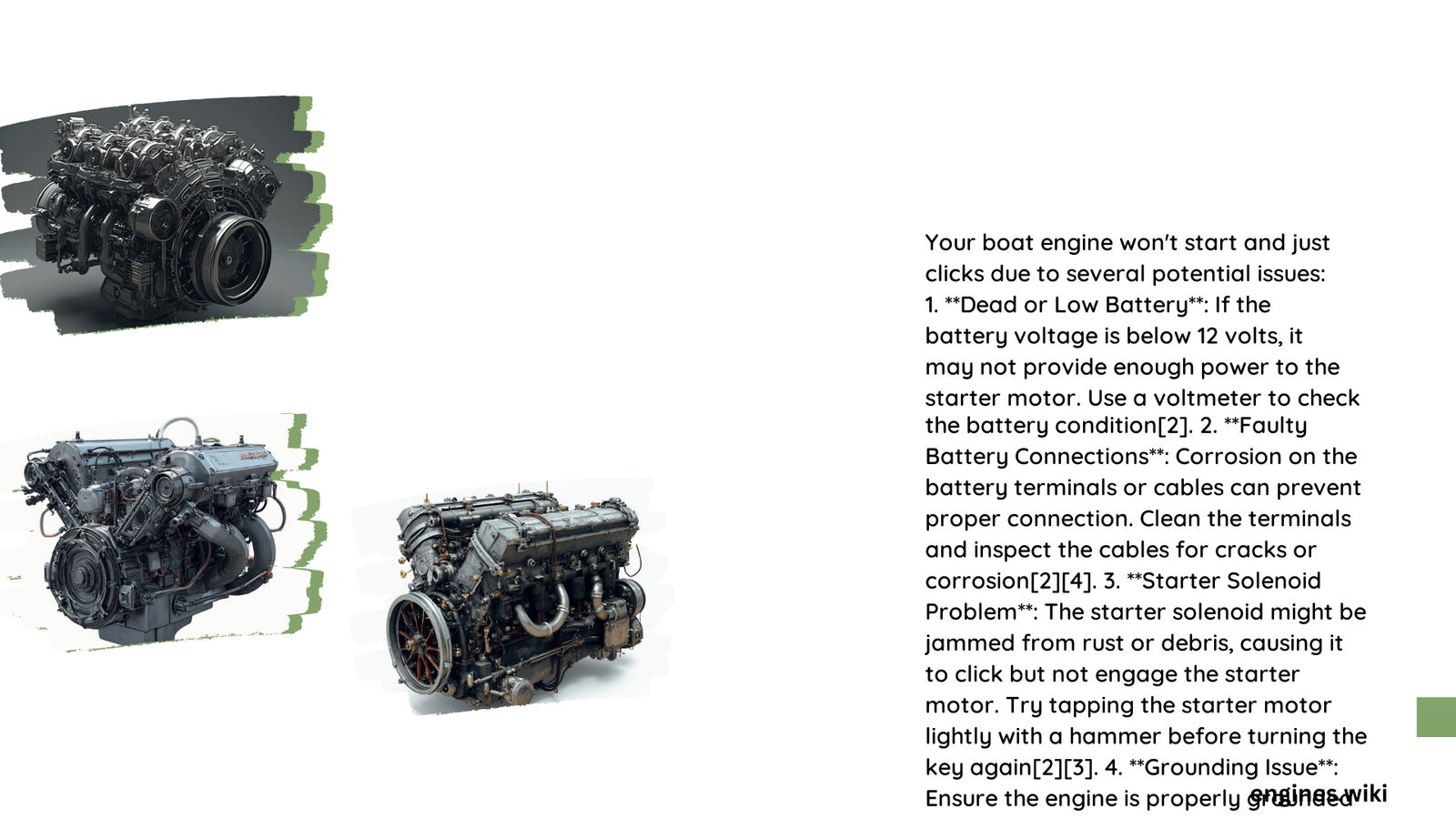When your boat engine fails to start and only produces a clicking sound, it can be frustrating and concerning. This issue is often related to electrical problems, particularly with the battery, starter motor, or ignition system. Understanding the root cause and knowing how to troubleshoot can help you get back on the water quickly and safely.
What Are the Common Causes of a Clicking Boat Engine?
Several factors can contribute to a boat engine that clicks but won’t start:
- Low battery voltage
- Faulty starter motor
- Corroded or loose connections
- Ignition switch problems
- Seized engine
Let’s explore each of these potential causes and their solutions in detail.
How Can I Diagnose a Low Battery Issue?

A low battery is often the primary culprit when your boat engine won’t start and just clicks. Here’s how to diagnose this issue:
-
Check the battery voltage: Use a multimeter to measure the battery’s voltage. A healthy 12V marine battery should have a resting voltage between 12.6 to 12.7 volts. If it’s below 12.4 volts, it may need charging or replacement.
-
Perform a load test: This test checks the battery’s ability to hold a charge under load. Many auto parts stores offer this service for free.
-
Inspect for corrosion: Look for white, green, or blue buildup on the battery terminals. Clean any corrosion with a wire brush and a mixture of baking soda and water.
-
Check connections: Ensure all battery connections are tight and free from corrosion.
If your battery voltage is low, charge it using a marine battery charger. If it doesn’t hold a charge, it’s time for a replacement.
What Are the Signs of a Faulty Starter Motor?
A faulty starter motor can also cause clicking without engine start. Here are some signs to look out for:
- Clicking sound when turning the key
- Grinding noise during start attempts
- Starter motor spinning without engaging the engine
- Smoke coming from the starter area
To diagnose a faulty starter motor:
-
Perform a voltage drop test: Measure the voltage drop across the starter motor connections while cranking the engine. A significant voltage drop (more than 0.5 volts) can indicate a problem.
-
Check for visible damage: Inspect the starter motor for signs of wear, corrosion, or physical damage.
-
Listen for abnormal sounds: A healthy starter should produce a consistent whirring sound. Grinding or excessive clicking may indicate issues.
If you suspect a faulty starter motor, it’s best to have it professionally inspected and replaced if necessary.
How Do Corroded or Loose Connections Affect Engine Starting?
Corroded or loose connections can prevent sufficient current from reaching the starter motor, resulting in clicking without starting. Here’s how to address this:
-
Inspect all connections: Check the battery terminals, starter motor connections, and ground connections for corrosion or looseness.
-
Clean corroded areas: Use a wire brush and a baking soda solution to clean any corrosion.
-
Tighten loose connections: Ensure all connections are secure but not over-tightened.
-
Apply dielectric grease: After cleaning and tightening, apply dielectric grease to prevent future corrosion.
Regular maintenance of your boat’s electrical connections can prevent many starting issues.
What Role Does the Ignition Switch Play in Starting Problems?
A faulty ignition switch can prevent the starter motor from receiving the signal to engage. Here’s how to troubleshoot:
-
Check for power at the switch: Use a multimeter to test for voltage at the ignition switch when in the start position. You should see battery voltage (around 12 volts) if the switch is functioning correctly.
-
Listen for the click: When you turn the key, you should hear a click from the starter solenoid. If you don’t, the ignition switch may not be sending the signal.
-
Inspect wiring: Look for any damaged or loose wires connected to the ignition switch.
If you suspect an ignition switch issue, it’s best to have it diagnosed and replaced by a marine mechanic.
Could a Seized Engine Cause Clicking Without Starting?
While less common, a seized engine can cause clicking without starting. This occurs when internal engine components are locked up, preventing rotation. Signs of a seized engine include:
- Clicking sound when trying to start
- Inability to turn the engine over manually
- Sudden loss of power before the last shutdown
To check for a seized engine:
-
Try to turn the flywheel: With the spark plugs removed, attempt to turn the flywheel by hand. If it doesn’t move, the engine may be seized.
-
Check for water in cylinders: Remove the spark plugs and look for water in the cylinders, which can cause seizure.
-
Inspect for visible damage: Look for signs of impact or severe corrosion that might have caused internal damage.
A seized engine typically requires professional repair or replacement.
What Steps Should I Take to Troubleshoot My Clicking Boat Engine?
Follow these steps to diagnose and potentially resolve your boat’s starting issue:
- Check battery voltage and connections
- Inspect and clean all electrical connections
- Test the starter motor
- Verify ignition switch functionality
- Attempt to turn the engine manually (if safe to do so)
- Listen for unusual sounds during start attempts
- Consult a marine mechanic if the issue persists
Remember, safety should always be your priority when working on boat engines. If you’re unsure about any step, consult a professional.
By following these troubleshooting steps, you can often identify and resolve the issue causing your boat engine to click without starting. Regular maintenance and prompt attention to electrical issues can help prevent future starting problems and ensure your boat is always ready for your next adventure on the water.
